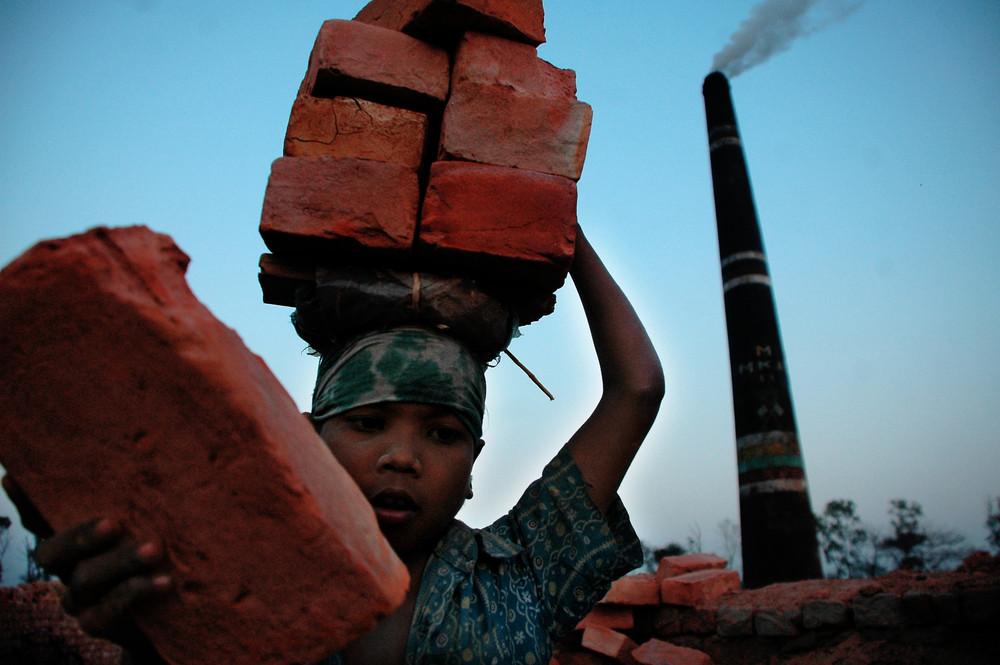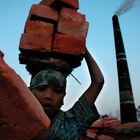Childhood spent in building bricks
Bangladesh has ratified the UN Convention for Child Rights and yet, across the nation, poverty forces many children to take up many professions considered dangerous even for adults. In this photo, a child is seen carrying newly-made bricks working at a brick field in Bhola, an island in southern Bangladesh. A child works 10 hours on a usual day to earn Taka 60 (US 85 cents) in a brick field.










OLD No13 23/01/2014 12:02
Well done Image of child povertyAll of us must start the CHANGE NOW - Our common Goal must START NOW :
Investing in children: breaking the cycle of disadvantage NOW
Child Poverty in Europe based on EUROCHILD REPORT:
About half of Member States identify child poverty and social exclusion at least to some extent as an important issue in their 2013 National Reform Programs (NRPs).
However, of these only six Member States (CY, DK, EL, ES, IE, UKS) give a fairly high priority to the issue of child poverty and social exclusion.
For instance:
- the Cypriot NRP’s first priority is to maintain or lower child poverty and social exclusion;
- the Danish NRP highlights the Government aims to reduce poverty and give special priority to socially disadvantaged children and young people;
- in the Greek NRP child poverty is identified as an important issue, mentioned under the main challenges;
- Ireland’s 2013 NRP update identifies poverty as one of the five central target areas, within which the particular vulnerability to poverty of children and lone parent families is recognized;
- in the Scottish NRP tackling poverty and especially child poverty and social exclusion is a high priority within a chapter on equity;
- in Spain, for the first time (since 2011 NRP) the government included child poverty as a priority on social policies, as part of the NRP.
Several other countries (e.g. BG, CZ, DE, DK, FI, FR, HU NL, PT, RO), while not making child poverty and social exclusion a high priority, do give attention to some aspects.
For instance:
- the Bulgarian NRP addresses several aspects of child poverty and social exclusion, in particular improving the effectiveness of social payments, improving access to quality services for children, promoting Roma integration and ensuring access to education for disadvantaged groups. Unfortunately often the measures outlined are too aspirational and an insufficient response to the scale of the challenge;
- the Czech NRP does not have a specific focus on child poverty but does refer to the Strategy to Combat Social Exclusion for 2011 – 2015, where one of the aims are focus on participation of socially disadvantaged children into mainstream education (not to exclude them into special schools) and prevention of family breakdown and prevention of placing children into institutional care;
- the Danish NRP mentions that the Government aims to reduce poverty and give special priority to socially disadvantaged children and young people;
- the Estonian NRP considers the coping of families and children to be important and gives particular attention to educational disadvantage and school drop-out;
- Finland’s NRP highlights the growing number of low-income families with children, but does not cover child poverty separately and overall gives very little in-depth attention to the whole issue;
- the German NRP acknowledges that child poverty and social exclusion is a challenge but does not elaborate on measures to address it in the NRP as it considers that the NSR is the instrument for social policy reporting;
- the Hungarian NRP considers social inclusion as an important issue and refers to children, among other groups, as a target of intervention; the NRP acknowledges the growing number of children who live in poverty, the identification of the issue is well, but the planned measures and interventions to tackle social exclusion and child poverty are insufficient, limited, fragmented and not universal.
- the Italian NRP mentions child poverty when talking of welfare and poverty and in addressing Support actions to very poor families, but it does not seem an important issue as such, it rather seems included in the big box of fight to poverty and social exclusion;
- the Lithuanian NRP, while not explicitly identifying child poverty and social exclusion as an important issue, does submit that one of the key tasks for Lithuania in 2013 is to prepare the action plan for the reduction of social exclusion for 2014–2020 with a special focus on children and youth;
In God we trust
God bless you all